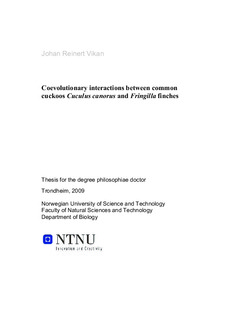| dc.description.abstract | Most open nesting insectivorous passerines in Europe have a history of interaction with the brood parasitic common cuckoo. These interactions are pair-wise and strongly antagonistic, and may therefore lead to tight reciprocal evolution of adaptations and counter-adaptations in an arms race like fashion. This thesis deals with evolutionary aspects of the relationship between the cuckoo and two Fringillidae hosts, the brambling Fringilla montifringilla and chaffinch F. coelebs. These species are representatives of a large segment of poorly investigated hosts covering many taxa that have evolved comparatively advanced adaptations for combating the cuckoo.
We documented parasitism on bramblings in north western Finland, where average parasitism rate over three years was 6%. Historical data suggests that presence of parasitism is stable to some extent in this part of Fennoscandia. Two Norwegian and one Swedish population were not parasitised. The one chaffinch population we studied is not parasitised, and we know of no cases of regular parasitism on this species from elsewhere.
In agreement with previous studies on these two hosts, we found that egg rejection is regulated by a simple recognition system, where the acceptance threshold employed by the host, i.e. the magnitude of dissimilarity between own and parasite eggs that trigger a rejection response, is relatively fixed regardless of context. Furthermore, recognition is memory based, with no or negligible contribution of discordancy, i.e. direct comparison of eggs.
We found no noticeable variation in egg rejection behaviour between the four brambling populations. Most individuals rejected non-mimetic eggs, and the relationship between host-parasite egg dissimilarity and rejection probability was the same in all populations. Furthermore, bramblings very rarely made misstakes in rejection, suggesting that this behaviour is robust to decay. The ubiquitous presence of precise egg rejection has most likely arisen because bramblings lack breeding site fidelity, and because the average parasitism pressure has been high enough in the past to drive regional fixation of rejection alleles and evolution of clutch characteristics that facilitate cost free egg recognition.
There was no notable difference in the rejection behaviour of bramblings and chaffinches. The degree of matching in chromatic aspects of egg color, i.e. hue and chroma, was an important factor affecting rejection probability in both species. Difference in achromatic aspects (brightness) was overall less important, as expected when object discrimination takes place under the light conditions present in open, shallow nests. Given that egg colour is a remarkably variable trait in both species, and because the heritability of egg color is known to be high, coevolution should be strongly focussed on egg colour in both species.
By combining an experimentally derived host discrimination function with the current distributions of host and cuckoo egg phenotypes, we documented a cost to commonness in bramblings, i.e. common phenotypes are more likely to be successfully parasitised. This provides indirect evidence that cuckoos in principle can drive coevolutionary cycles in natural populations. Moreover, we found that cuckoos parasitising the Finnish population layed eggs that were close to the optimal phenotype. These cuckoo eggs were also equally good matches to brambling eggs in two distant, unparasitised populations. This indicates that cuckoos and bramblings are close to a matching equilibrium in Fennoscandia, a possibility also supported by analyses of museum data covering the period 1881-1940. In the museum material, there was no variation in cuckoo or host egg appearance along latitudinal or longitudinal gradients.
We suggest that high rates of brambling gene flow cools down potential coevolutionary hot spots by cancelling out much of the selection imposed by the patchily distributed cuckoo host race. This limits host evolution and allows the host race to adapt to the brambling’s egg phenotype distribution, thereby possibly promoting overall persistence of this interaction. Our studies on bramblings collectively indicate that the scale of geographically structured coevolution between bramblings and cuckoos possibly encompasses the whole of Fennoscandia.
In contrast, we found that the chaffinch has evolved a markedly more bimodal egg color distribution, consistent with the direction of evolutionary change predicted for the brambling. This difference is in accordance with the observation that chaffinches are more site fidelic than bramblings, and should therefore be better able to respond to disruptive selection imposed by locally adapting cuckoos. Surprisingly, simulation of increasingly bimodal host egg color distributions did not give rise to corresponding fitness peaks for cuckoo egg color. Marked and parallel egg polymorphisms are therefore unlikely as local coevolutionary outcomes in these systems. Frequency dependent selection is expected to create a temporal pattern of matching and mismatching of phenotypes, and might be an explanation for the current lack of regular parasitism on chaffinches since cuckoo populations could face problems with persisting during the lag phase. | nb_NO |
| dc.relation.haspart | Aviles, J. M.; Vikan, J. R.; Fossoy, F.; Antonov, A.; Moksnes, A.; Roskaft, E.; Stokke, B. G.. Avian colour perception predicts behavioural responses to experimental brood parasitism in chaffinches. Journal of Evolutionary Biology. (ISSN 1010-061X). 23(2): 293-301, 2010. <a href='http://dx.doi.org/10.1111/j.1420-9101.2009.01898.x'>10.1111/j.1420-9101.2009.01898.x</a>. | nb_NO |

